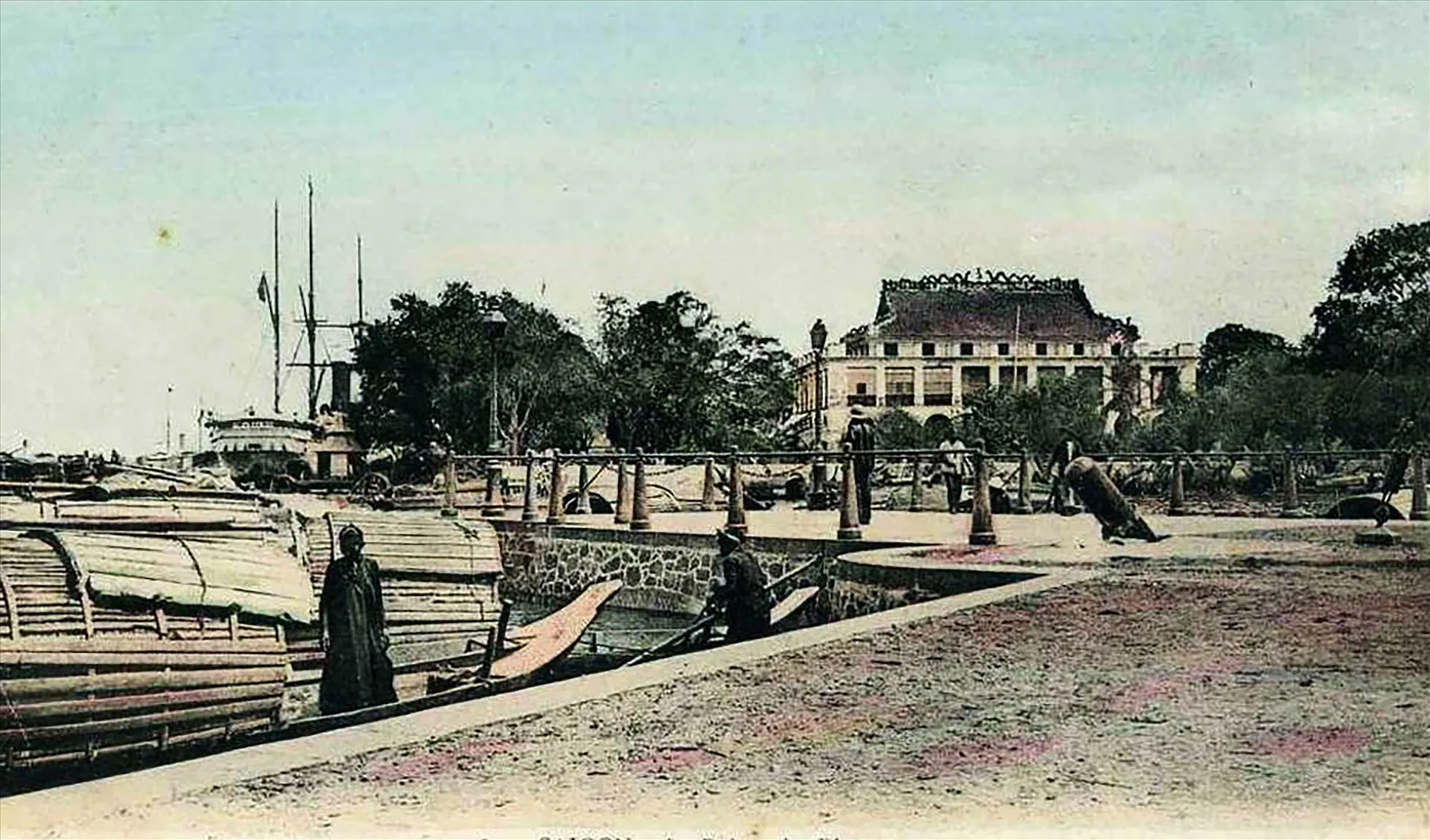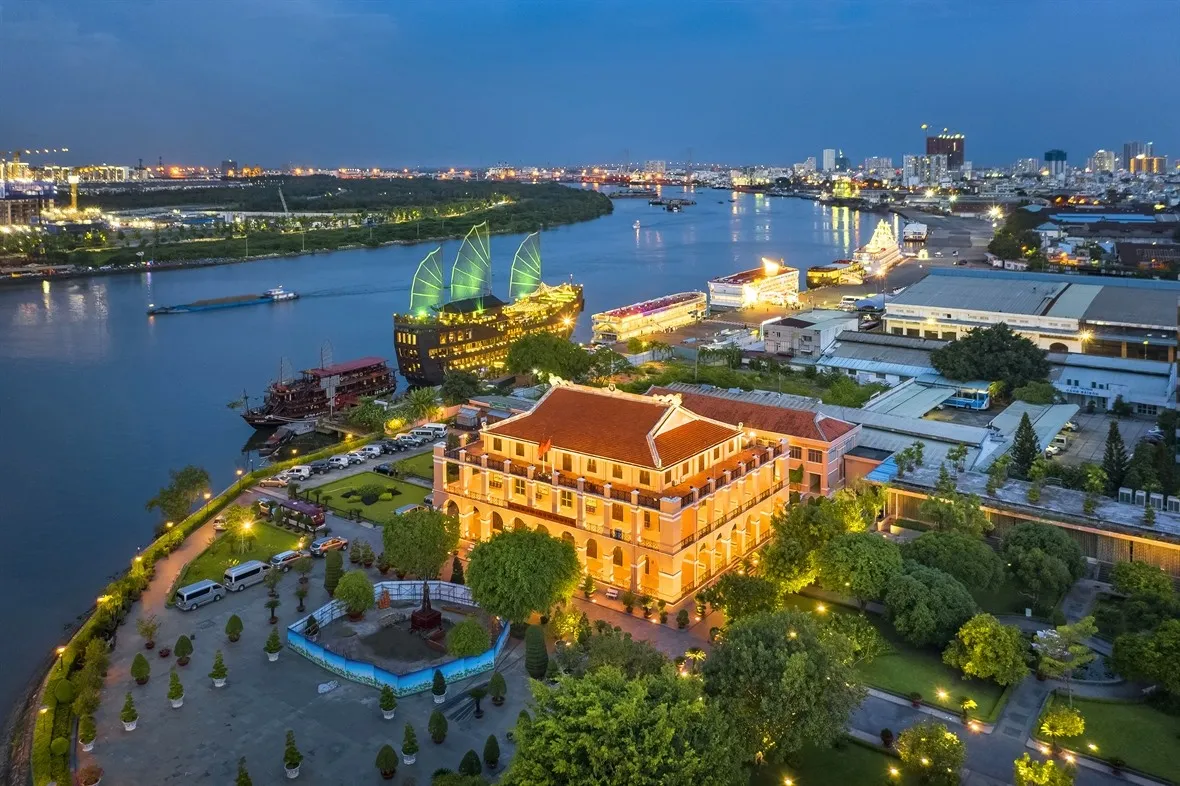Nha Rong Wharf, a site rich with historical significance, was not only a bustling commercial center but also the venue witnessing a pivotal moment in the quest for national independence led by President Ho Chi Minh. Here, he embarked on his journey, driven by the desire for freedom for Vietnam, heralding a new chapter in revolutionary history.

Nha Rong Wharf in the early 20th century, as documented by the French École Française d’Extrême-Orient (EFEO), serves as a testament to its long-standing history and importance.
Nha Rong Wharf: From A Trading Port to A Historical Icon
The origin of the name Nha Rong Wharf is still a topic of discussion, yet the most common explanation ties it to Ben Nghe, a wharf on the Tan Binh River (old name for the Saigon River). According to “Gia Dinh Thanh Thong Chi” by Trinh Hoai Duc, the river was large and deep, and crocodiles roared like calves calling their herd, thus earning the name Ben Nghe.
The Nha Rong building, constructed by the French in 1863 as the headquarters of Messageries Imperials, features Western architectural style adorned with two large dragons on its roof, showcasing a unique cultural fusion. The “Two Dragons Competing for the Moon” design, familiar in Vietnamese temple architecture, contributed to its name, leaving a Vietnamese mark on a French structure.
As detailed in “Gia Dinh – Saigon – Ho Chi Minh City Geography,” the old Ben Nghe was a bustling commercial port, full of boats and vibrant trade activities. It became a strategic gathering point due to its advantageous position against floods and agreeable climate, serving defense purposes for the southern part of Vietnam.
The “Gia Dinh Thanh Thong Chi” depicts Ben Nghe as a place where “our merchant ships and those from other nations docked, with masts lined up one after another,” affirming Ben Nghe’s vital role in Southeast Asian trade.
During the French invasion, Ben Nghe became a historical witness. Nguyen Dinh Chieu expressed the pain of losing his homeland in “Van Te Truong Dinh” as follows: “The sky over Ben Nghe rains continuously, mourning the hero in distress; The land of Go Cong, plants are withered, grieving the loyal servant.”

Today, Nha Rong Wharf stands as a famous tourist destination, preserving its heroic stories and inviting visitors to explore the past.
Nha Rong Wharf and Ho Chi Minh’s Legacy
On June 5, 1911, Nha Rong Wharf witnessed a monumental historical event. Here, young Nguyen Tat Thanh, known as Van Ba, boarded the Amiral Latouche Tréville, setting out on a mission to save his nation.
With grand ambitions and sharp political vision, Nguyen Tat Thanh decided to head West for observation and learning. He once said: “I want to go overseas to see France and other countries. After observing how they do things, I will return to help our compatriots.”
On July 6, 1911, the ship arrived at Marseilles, France. Nguyen Tat Thanh realized that even in Western countries, poverty persisted just like in Vietnam. This realization fueled his resolve to labor for the chance to seek the truth.
Throughout his travels across Asia, Europe, America, and Africa, Nguyen Tat Thanh comprehended the essence of imperialism and the sufferings of colonial peoples. He embraced Marxism-Leninism and committed to following the path of the October Revolution, the path to national liberation.
After 30 years of wandering, learning, and studying, Nguyen Ai Quoc returned to the homeland, carrying the path of revolution and the way to Vietnamese national liberation. This path became the foundation for every victory in the Vietnamese revolution.
Nha Rong Wharf: From Past to Future
Nha Rong Wharf is not only a witness to significant historical events but also symbolizes the spirit of struggle for independence and national unity. On April 30, 1975, the red flag with a golden star flew over Nha Rong Wharf, marking Vietnam’s victory.
Immediately after reunification, the building was preserved as a Memorial Site for President Ho Chi Minh per Decision No. 1315/QD-UB issued on July 9, 1979, by the Ho Chi Minh City People’s Committee. With its unique architecture merging European art and Southeast Asian designs, Nha Rong Wharf became a special cultural heritage of the city.
Currently, Nha Rong Wharf is the Ho Chi Minh Museum – Ho Chi Minh City branch, located at 1 Nguyen Tat Thanh Street, District 4. It houses and displays artifacts and images recounting the life and revolutionary career of President Ho Chi Minh, especially his quest for national salvation.
Nha Rong Wharf carries profound historical significance for Vietnamese people. It represents not only the starting point of Ho Chi Minh’s quest but also a place for visitors to learn about national history and culture.
Nha Rong Wharf is a must-visit destination for those interested in Vietnamese history and wanting to honor President Ho Chi Minh. It epitomizes the spirit of patriotism, the resolve to fight, and the aspiration for peace in the Vietnamese nation.
Nha Rong Wharf is an indispensable part of the historical and cultural tapestry of Vietnam, a living testament to a heroic past and a source of inspiration for a bright future.